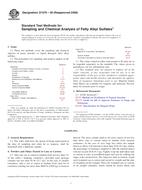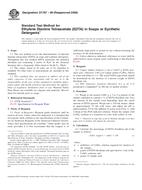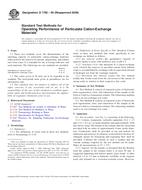Potřebujeme váš souhlas k využití jednotlivých dat, aby se vám mimo jiné mohly ukazovat informace týkající se vašich zájmů. Souhlas udělíte kliknutím na tlačítko „OK“.
ASTM D3375-95a(2007)
Standard Test Method for Column Capacity of Particulate Mixed Bed Ion Exchange Materials (Withdrawn 2016) (Includes all amendments And changes 7/29/2016).
Automaticky přeložený název:
Standardní zkušební metoda pro Kapacita sloupce částic Mixed katexu materiály
NORMA vydána dne 1.12.2007
Informace o normě:
Označení normy: ASTM D3375-95a(2007)
Poznámka: NEPLATNÁ
Datum vydání normy: 1.12.2007
Kód zboží: NS-23463
Počet stran: 4
Přibližná hmotnost: 12 g (0.03 liber)
Země: Americká technická norma
Kategorie: Technické normy ASTM
Kategorie - podobné normy:
Anotace textu normy ASTM D3375-95a(2007) :
Keywords:
column capacity, conductivity, ion exchange, mixed bed, Column capacity, Conductance and conductivity (electrical) water, Deionization, Ion exchange resins, Mixed-bed ion-exchange resins, Performance water analysis equipment, ICS Number Code 71.100.40 (Surface active agents)
Doplňující informace
| Significance and Use | ||||||||||||
|
This test method can be used to evaluate unused mixed bed ion exchange materials for conformance to specifications. When a representative sample of the mixed bed can be obtained from an operating unit, this test method can be used to evaluate the regeneration efficiency by comparison with the same data obtained with new material from the same manufactured lots, or retained samples of the in-place products. This test method provides for the calculation of capacity in terms of the volume of water treated to a conductivity end point. The test method as written assumes that the cation exchange material has been regenerated to the hydrogen form with acid and the anion exchange material has been regenerated with alkali to the hydroxide or free-base form. In certain applications a cation exchange material in the potassium, ammonium, or other monovalent form may be encountered. Such materials may be tested following this procedure using Test Water A (Test Methods D 1782) as the influent and substituting the hardness end point (Test Methods D 1782) for the end points prescribed herein. In most cases the product tested will be properly mixed and will contain the correct proportions of anion and cation exchange materials. However, if the pH as well as the conductivity of the effluent is measured, the test method will indicate which of the components is present in excess; an acid effluent at breakthrough indicating an excess of regenerated cation exchange groups and an alkaline effluent an excess of regenerated anion exchange groups. In such cases the volumes of the two components obtained in the final backwash will indicate whether this imbalance arises from improper regeneration or from an improper ratio of the two components. It should be noted, however, that not all units are charged with a balanced ratio of anion-exchanging and cation-exchanging groups. Hence, wherever possible, a field sample should be evaluated in comparison with a retained sample of the original charge. This test method provides for the calculation of capacity on either a wet weight basis or a volume basis. Although such materials are normally bought and sold in terms of cubic feet, they are actually packaged in wet pounds. Therefore, it is the capacity on a wet weight basis that is directly correlatable to the amount of material in a given shipment. Calculation of a volume capacity is based on the exhausted, separated volume of the components after backwashing and resettling the bed. This volume is chosen because it is difficult, if not impossible, to pack a sample of regenerated mixed bed material in a small-diameter column reproducibly. This test method may be used to test mixed bed resin cartridges. In such cases the flow rate of test water and the frequency of sampling must be varied to compensate for the approximate volume of resin in the test sample. The test as written assumes a resin volume of approximately 330 mL. |
||||||||||||
| 1. Scope | ||||||||||||
|
1.1 This test method covers the determination of the performance of particulate mixed bed ion exchange materials in the regenerated form when used for deionization. It is intended for use in testing unused mixed bed materials and samples of regenerated mixed beds from operating units. 1.2 This standard does not purport to address all of the safety concerns, if any, associated with its use. It is the responsibility of the user of this standard to establish appropriate safety and health practices and determine the applicability of regulatory limitations prior to use. |
||||||||||||
| 2. Referenced Documents | ||||||||||||
|
Podobné normy:
Historická
1.10.2009
Historická
1.1.2014
Historická
1.10.2009
Historická
1.10.2009
Historická
1.5.2009
Historická
1.10.2009
Doporučujeme:
Aktualizace zákonů
Chcete mít jistotu o platnosti užívaných předpisů?
Nabízíme Vám řešení, abyste mohli používat stále platné (aktuální) legislativní předpisy.
Chcete vědět více informací? Podívejte se na tuto stránku.



 ASTM D1570-95(2009)..
ASTM D1570-95(2009).. ASTM D1681-05(2014)..
ASTM D1681-05(2014).. ASTM D1767-89(2009)..
ASTM D1767-89(2009).. ASTM D1768-89(2009)..
ASTM D1768-89(2009).. ASTM D1782-95(2009)..
ASTM D1782-95(2009).. ASTM D2023-89(2009)..
ASTM D2023-89(2009)..
 Cookies
Cookies
